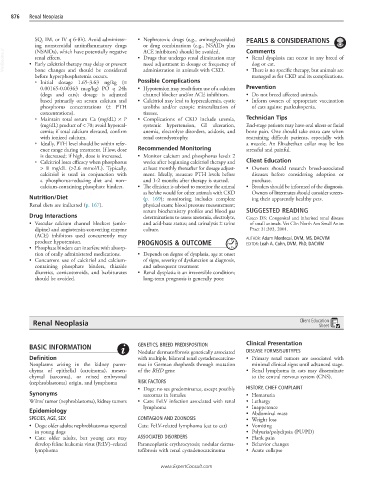Page 1743 - Cote clinical veterinary advisor dogs and cats 4th
P. 1743
876 Renal Neoplasia
SQ, IM, or IV q 6-8h). Avoid administer- • Nephrotoxic drugs (e.g., aminoglycosides) PEARLS & CONSIDERATIONS
ing nonsteroidal antiinflammatory drugs or drug combinations (e.g., NSAIDs plus Comments
VetBooks.ir • Early calcitriol therapy may delay or prevent • Drugs that undergo renal elimination may • Renal dysplasia can occur in any breed of
ACE inhibitors) should be avoided.
(NSAIDs), which have potentially negative
renal effects.
need adjustment in dosage or frequency of
dog or cat.
bone changes and should be considered
managed as for CKD and its complications.
before hyperphosphatemia occurs. administration in animals with CKD. • There is no specific therapy, but animals are
○ Initial dosage 1.65-3.63 ng/kg (= Possible Complications
0.00165-0.00363 mcg/kg) PO q 24h • Hypotension may result from use of a calcium Prevention
(dogs and cats); dosage is adjusted channel blocker and/or ACE inhibitors. • Do not breed affected animals.
based primarily on serum calcium and • Calcitriol may lead to hypercalcemia, cystic • Inform owners of appropriate vaccination
phosphorus concentrations (± PTH uroliths and/or ectopic mineralization of of cats against panleukopenia.
concentrations). tissues.
○ Maintain total serum Ca (mg/dL) × P • Complications of CKD include uremia, Technician Tips
(mg/dL) product of < 70; avoid hypercal- systemic hypertension, GI ulceration, End-stage patients may have oral ulcers or facial
cemia; if total calcium elevated, confirm anemia, electrolyte disorders, acidosis, and bone pain. One should take extra care when
with ionized calcium. renal osteodystrophy. restraining difficult patients, especially with
○ Ideally, PTH level should be within refer- a muzzle. An Elizabethan collar may be less
ence range during treatment. If low, dose Recommended Monitoring stressful and painful.
is decreased; if high, dose is increased. • Monitor calcium and phosphorus levels 2
○ Calcitriol loses efficacy when phosphorus weeks after beginning calcitriol therapy and Client Education
> 8 mg/dL (>2.6 mmol/L). Typically, at least monthly thereafter for dosage adjust- • Owners should research breed-associated
calcitriol is used in conjunction with ment. Ideally, measure PTH levels before diseases before considering adoption or
a phosphorus-reducing diet and non– and 1-2 months after therapy is started. purchase.
calcium-containing phosphate binders. • The clinician is advised to monitor the animal • Breeders should be informed of the diagnosis.
as he/she would for other animals with CKD Owners of littermates should consider screen-
Nutrition/Diet (p. 169); monitoring includes complete ing their apparently healthy pets.
Renal diets are indicated (p. 167). physical exam; blood pressure measurement;
serum biochemistry profiles and blood gas SUGGESTED READING
Drug Interactions determinations to assess azotemia, electrolyte, Greco DS: Congenital and inherited renal disease
• Vascular calcium channel blockers (amlo- and acid-base status; and urinalysis ± urine of small animals. Vet Clin North Am Small Anim
dipine) and angiotensin-converting enzyme culture. Pract 31:393, 2001.
(ACE) inhibitors used concurrently may AUTHOR: Adam Mordecai, DVM, MS, DACVIM
produce hypotension. PROGNOSIS & OUTCOME EDITOR: Leah A. Cohn, DVM, PhD, DACVIM
• Phosphate binders can interfere with absorp-
tion of orally administered medications. • Depends on degree of dysplasia, age at onset
• Concurrent use of calcitriol and calcium- of signs, severity of dysfunction at diagnosis,
containing phosphate binders, thiazide and subsequent treatment
diuretics, corticosteroids, and barbiturates • Renal dysplasia is an irreversible condition;
should be avoided. long-term prognosis is generally poor.
Renal Neoplasia Client Education
Sheet
BASIC INFORMATION GENETICS, BREED PREDISPOSITION Clinical Presentation
Nodular dermatofibrosis genetically associated DISEASE FORMS/SUBTYPES
Definition with multiple, bilateral renal cystadenocarcino- • Primary renal tumors are associated with
Neoplasms arising in the kidney paren- mas in German shepherds through mutation minimal clinical signs until advanced stage.
chyma of epithelial (carcinoma), mesen- of the BHD gene • Renal lymphoma in cats may disseminate
chymal (sarcoma), or mixed embryonal to the central nervous system (CNS).
(nephroblastoma) origin, and lymphoma RISK FACTORS
• Dogs: no sex predominance, except possibly HISTORY, CHIEF COMPLAINT
Synonyms sarcomas in females • Hematuria
Wilms’ tumor (nephroblastoma), kidney tumors • Cats: FeLV infection associated with renal • Lethargy
lymphoma • Inappetence
Epidemiology • Abdominal mass
SPECIES, AGE, SEX CONTAGION AND ZOONOSIS • Weight loss
• Dogs: older adults; nephroblastomas reported Cats: FeLV-related lymphoma (cat to cat) • Vomiting
in young dogs • Polyuria/polydipsia (PU/PD)
• Cats: older adults, but young cats may ASSOCIATED DISORDERS • Flank pain
develop feline leukemia virus (FeLV)–related Paraneoplastic erythrocytosis; nodular derma- • Behavior changes
lymphoma tofibrosis with renal cystadenocarcinoma • Acute collapse
www.ExpertConsult.com

